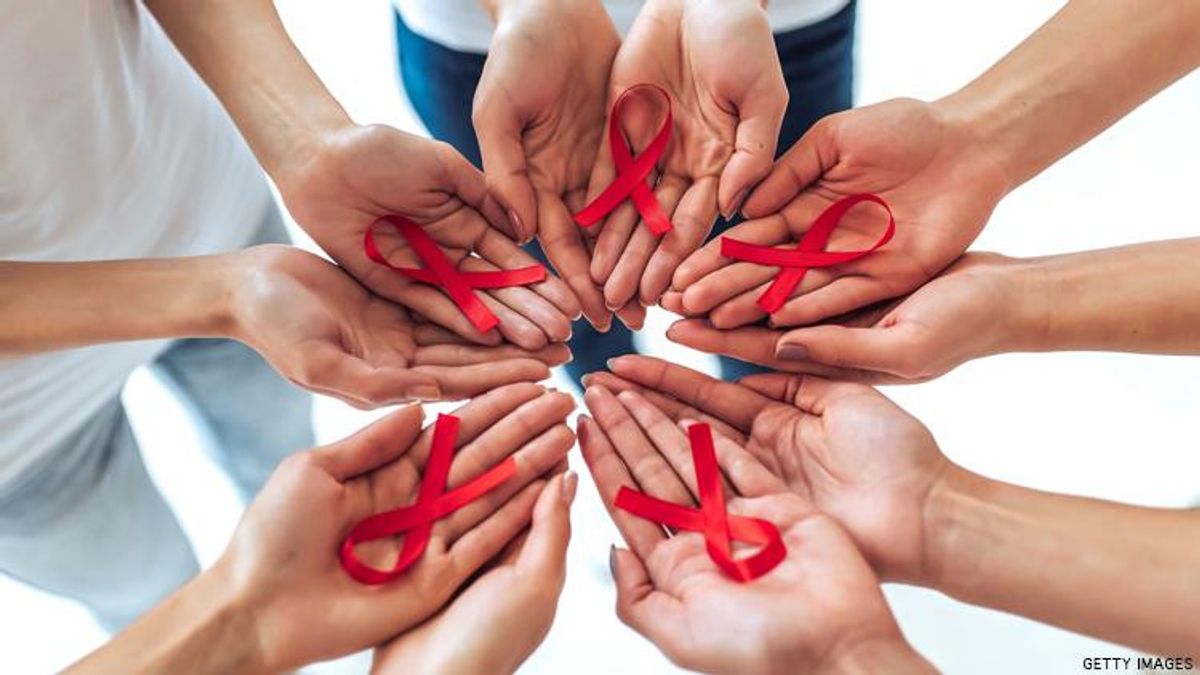Originally from San Luis Potosi in central Mexico, San Francisco’s Jesús Guillén, 61, is a musician, vocalist, photographer, spiritual healer, and a long-term survivor (LTS). After living with HIV for over three decades, he is partially disabled from neuropathy (a form of nerve damage), a side effect from a pre-antiretroviral drug regimen, and suffers from chronic pain. Guillén also went through a brutal battle with lymphoma and deals with PTSD, primarily due to living through the early years of the AIDS epidemic and seeing so many of his peers succumb to the virus.
It’s because of issues like these, especially around mental health, that Guillén founded his Facebook group, HIV Long-Term Survivors, in 2016 — which is now over 5,000 members strong. “I like to think that we are helping with the main problems of isolation and loneliness,” he says. Guillén also appeared in Last Men Standing, the 2016 award-winning documentary film about long-term HIV survivors.

Founder of the 'HIV Long-Term Survivors' group on Facebook, Jesús Guillén
In this very special issue focusing on long-term survivors and older adults living with HIV, several members of Guillén’s Facebook group opened up about their journeys of living with HIV for decades. Though there is certainly tragedy and hardship throughout their stories, all is not doom and gloom. In fact, we hope you’ll find inspiration in their strength, dignity, and perseverance.

MARK'S STORY
“I was initially diagnosed with HIV at an anonymous test site in Denver, Colo., after being advised to by a doctor after being diagnosed with a shingles outbreak,” recalls long-term survivor of HIV, Mark Janes. “There was still some pain and sleep deprivation from the shingles, so when the man told me, I was somewhat numb. He gave me a portfolio with information about resources. I thanked him and went out to my car.”
After surviving the initial shock of his diagnosis, Janes says he was hit with another devastating blow: he might not live for much longer.
“I then contacted my primary care doc and he re-ran the HIV screening test along with a T-cell panel. When that came back a couple weeks later, my initial CD4 count was 89. At that time that amounted to an AIDS diagnosis, and while my doctor refused to say how long I’d live, I was told it’d be wise to get my affairs in order. I’d already seen several people die from AIDS, and it basically shattered my world.”
Now that antiretroviral medication makes HIV a manageable condition, it may be hard to fathom what young people like Janes were experiencing at the time. But, for one moment, imagine what it would be like to be told your life would most likely be over in your 20s.
“I was very fortunate to have parents [and] other family and friends who were very supportive throughout the years I was struggling,” say Janes. “I was able to get onto newer drugs as they came out, then onto combinations, but wasn’t able to entirely hold off other opportunistic infections. I had outbreaks of Kaposi’s Sarcoma twice; chemo agents promptly brought those under control — but came at a cost of their own, along with what early HIV meds did. They kept us alive, but…very often at a cost.”
Then, says Janes, his HIV pharmacist called him to offer him a spot in an especially promising new drug trial.
“It involved mixing up and injecting a new type of HIV drug twice a day, subcutaneously,” he explains. “At that point I had just finished a second course of chemo, weighed 130 pounds, and had a CD4 count of 97.” In other words, he had nothing to lose.
Miraculously, the meds — an early form of today’s effective antiretroviral treatment — worked. And well. Within a month, “I had my viral load below detectable,” says Janes.
Now, a few decades later, Janes finds comfort and support in finding other folks living with HIV.
“In more recent years, a relative convinced me to open a Facebook account, and I found there that I could readily connect with others with HIV around the U.S. and the globe,” he says. “It was there that I met [prominent HIV activist] Maria Mejia. She asked me if I wanted to help her [administer] a group that would have a global reach; a place where those with HIV and their friends could gather without being bothered by the various scams and other pressures found online.”
Janes says the group has grown beyond what he’d ever imagined and he finds purpose and fulfillment in helping others living with HIV through the group.
“It’s gone from a few hundred members then to over 12,000 members today,” adds Janes. “Because of [Mejia] I have flown to Washington, D.C., several times — in order to learn more about HIV and outreach or to advocate for those who otherwise have no voice. I’m also often answering queries from around the globe, from matters as simple as what to do if you miss a dose to as specific as whether a given medication combination is safe for a mother nursing an infant. This has given me a way to make things better for those who’ve been diagnosed recently — and things are much better today than back a quarter century ago.”
Still, Janes says, long-term survivors of HIV continue to live with their share of challenges.
“Long-term survivors have a unique set of challenges, some of which were only discussed as problems for the future. For example, it was believed that some HIV meds could be harmful to the heart, kidneys, or liver, but that was seemingly far off. People were dying from AIDS then and there; anything that bought time was seen as a good thing. In those of us who survived, we have numerous bodily systems that are more aged than a healthy person our age. Many, if not most, have some degree of PTSD from living with something they’d seen brutally kill people they loved. And yet, the mainstream HIV community seemingly wants to move on, to sweep us grizzled old survivors under the rug.”
Despite the grief and suffering Janes has gone though, he remains resilient and still finds joy in all that life has to offer.
“I cook and bake, both for pleasure and to remain safe during COVID,” he says. “I like to walk into town, about a mile away, and I enjoy riding my motorcycle around west Sonoma County. When the mood strikes me or something needs to be said, I create memes and frames for social media.”

KEITH'S STORY
Keith Dole, 65, is a retired long-term survivor who loves “to garden, read, and exercise.” He first discovered he was HIV-positive in 1983.
“My partner got sick with AIDS,” recalls Dole. “Even though the ELISA test [the first test to detect HIV] didn’t come out until 1985, I knew deep down I had been infected. I was totally devastated. My whole world dropped out from under me. There were no medical or social support services available in Ft. Lauderdale in the early ’80s.”
Back then, Dole recalls people with living with HIV were ostracized and, with the exception of a few caring allies, often felt very much alone in the world.
“I was [my partner] Douglas’s sole caretaker,” he says. “We had no friends to rely on at that time. We had to travel to Miami to see the wonderful Dr. Margaret Fischl. My days consisted of working eight hours, then traveling one hour from Fort Lauderdale to South Miami to visit Douglas at night — and then coming home, going to bed, and starting all over again the next day.”
And the trauma didn’t end there, Dole says. There was little support to turn to when the hardest of times struck, and depression and grief took over.
“Douglas died at home in February 1985…. I had no support system to help me with my grief. I remember taking Benadryl to sleep all the time. That’s the only way I could handle it. I would work during the day, come home, take the pills, sleep, and on weekends I would take them during the day and sleep the weekends away.”
Still, greater challenges were to come for Dole — he still had to deal with his own HIV diagnosis. And workplace discrimination.
“When the test came out a bit later and my diagnosis was confirmed, I was told to ‘get my affairs in order.’ The doctor called me at work at American Express to tell me I was positive, and I broke down at my desk. My supervisor asked me what was wrong and I made the mistake of telling her. She rushed me down to the nurse’s office, where I was immediately sent home. The company doctor flew in from New York the next day and threatened me. [They told me] that I would lose my job if I told anyone…. They sent me to a psychiatrist to ensure that I wouldn’t spill the beans.”
Dole explains how very difficult those years were. “I lived with a loaded gun to my head from 1985 until the drug cocktails came out in early 1996. I tried AZT in the late ’80s, and I stopped because the side effects were so bad.”
Looking back he says, “It’s not been an easy journey. People who I have been with made me keep my status a secret. The only group support that I’ve received is from the long-term HIV survivor group on Facebook. I moved from Fort Lauderdale to Greensboro, N.C., in 1986 with Amex, and there really were no support systems in place here. That’s true to this day.”
On some of the biggest challenges facing long-term survivors today, Dole says the “management of comorbidities” is a common issue.
“I have bad neuropathy [from early HIV meds] in my feet and am unable to wear shoes and socks. I have cognitive problems, HAND [HIV-Associated Neurocognitive Disorder], chronic kidney disease, liver disease, high blood pressure, high cholesterol, arthritis, depression, anxiety, PTSD...[and] feeling invisible as we age.”
These days, Dole combats his depression and physical comorbidities through mindfulness and physical activity.
“I go to the gym five days a week. Because of the neuropathy, I exercise 30 minutes a day on a recumbent bicycle, three days a week. I do light weights to keep my bones strong, and my muscles toned…. I also meditate and read books on spirituality.”

TIM'S STORY
Tim Stancell-Condron, 62, has been living with HIV since the mid-1980s, and currently spends “quite a bit of my time volunteering. I am on the New England leadership board of the American Lung Association and am an active member of the Patient Advocacy Council at Dana Farber Cancer Institute, as a LTS with a history of lymphoma and small cell lung cancer. I also speak to various medical groups on my journey as a LTS of HIV.”
Stancell-Condron says he was he was in his mid-20s when he learned he was living with HIV.
“It was a mixture of terror, shame, guilt, and fear, as there were no drugs and everyone around me was starting to die. I never told anyone I was infected for over 12 years. Even after I got my AIDS diagnosis.”
Despite the trauma and terror of those days, Stancell-Condron says his journey living with HIV has been cathartic in many ways.
“As I look back, my journey has been wonderful, difficult, and blessed,” he says. However by the early ’90s, “I was diagnosed with full blown AIDS, [with] less than 100 T cells, pneumocystis pneumonia, and, at 6 feet tall, weighed less than 140 pounds.”
From there, his outlook only looked bleaker, says Stancell-Condron.
“In my late 30s I was diagnosed with stage 2 non-Hodgkin’s lymphoma, and in 2015 I was diagnosed with small cell lung cancer, with less than a 20 percent chance of survival. And recently, I left the workforce due to mild cognitive impairment due to HIV and chemo.”
Despite his physical ailments and PTSD related to HIV, Stancell-Condron says he still has always tried to remain positive, even when there was little hope to cling to.
“Even with all these issues, I never let it stop me from moving forward and living. I have, and have had, wonderful people and family in my life. I have done so much and am so grateful today. The positive outweighs the health issues by a long shot.”
However, coping with all this trauma has been difficult at times, he admits. But he finally found the courage to own his diagnosis.
“I kept my HIV hidden for a very long time,” Stancell-Condron says. “Honestly, I had never spoken with family and friends about my HIV until the last couple years. I used to be so ashamed and afraid of the stigma, and the fear of being discriminated in the workforce. So, I never really asked for the support until recently. My coping skills were fear and denial.”
As far as the biggest challenges today facing long-term survivors, Stancell-Condron says, “I worry, as we age, the story is getting lost and it is such an important part of history that needs to be told — and should be taught in every classroom. We need to keep the story alive. I also worry that younger doctors today don’t understand the type of care we have received in the past and I worry LTS are not getting the care they need. That is why I speak to groups of younger doctors and caretakers.”
These days in order to stay happy and healthy, Stancell-Condron says, “I meditate every morning, bike or walk, and try to do yoga in the evenings.”

SHELBY'S STORY
Since the beginnings of the epidemic, HIV has disproportionately affected gay and bisexual men, so we often forget that there are others — like women and youth — who are long-term survivors as well. One such person is Shelby Ann Welchel.
Welchel is truly a survivor in more ways than one. Before being diagnosed as HIV-positive 40 years ago, she survived a horrific act of violence that took the life of her young son and nearly left her dead.
In 1982, Welchel says, “I was diagnosed [after] a man shot and killed my 18-month-old son and proceeded to shoot me in the face, head, and back, and then he turned the gun on himself. When I woke up from a two-and-a-half-year coma in the hospital in February 1985, I was told that I had “GRID” [gay-related immune deficiency, the first name for HIV and its effects]. There were only 15 [known cases] of us women in the world that had GRID!”
After some difficult years dealing with the trauma and grief of what had happened to her, Welchel explains that in many ways, it was also a period of rebirth for her.
“So, this is when my life started,” she says. “Well, I was in recovery for two years and when I came out, I became a self-taught abstract artist. I finished school, got my associate’s degree and started working as a caseworker with women and men that had domestic violence issues, and also with AIDS foundations and organizations in [various] states.”
Welchel says it was through helping others that she finally began to find some healing and a sense a purpose.
“I worked 35-plus years in different foundations, organizations, and networks in the HIV/AIDS world — with men, women, and children,” she says. “It was and still is my world. I was very successful in helping others and there is not a day I regret working in communities with HIV/AIDS. This is family to me.”
“They have been my support system throughout the last 40 years — and I will continue to be their support system,” adds Welchel. “I will continue to help anybody and everybody that I can until the day I die…and I hope that won’t be for another 40 years…. I am blessed and I am an artist and I am a survivor. I love you all for life!”

DAVID'S STORY
David Spiher, 63, says he first discovered he was living with HIV in “Columbus, Ohio, in December 1985, as part of the first publicly available HIV tests at an STD clinic. I got a handshake and best wishes. I was 27, working a minimum wage job at $6 and change an hour with no health insurance. For the next nine months I went to work and to my 12-step recovery meeting and then to bed, basically waiting to die. AZT wasn’t even on the horizon yet.”
His life did eventually improve, but Spiher still went through some difficult years due to stigma and HIV discrimination.
“I was out as a person with HIV in my recovery meetings [and] therapies, but not in any of my jobs until 2016. Employers and people would say it didn’t matter, but you know it eventually did, and people would be ‘let go’ for being 10 minutes late — that kind of passive-aggressive employers covering their asses stuff. I decided to make the artwork I wanted to make and to keep myself employed.”
Spiher says happiness came into his life when he found love. However, that would eventually create another hardship to bear. “In 2003, I met my husband, who was newly diagnosed at the time…. We were together for 16 years when he died from early onset Alzheimer’s, likely accelerated by his HIV status.”
Now living in Hawaii, Spiher says the island paradise is not without its problems.
“I now live in rural Hawaii, health care in general and HIV care specifically are scarce on the ground,” he says, adding that many of the locals “culturally look down on public conversation, and those having that conversation, about health care and HIV. The state is very small — everyone knows everyone eventually. I understand it has ‘gotten better’ but it truly is a thing here.”
He also explains that the COVID-19 crisis has only added to the heavy load long-term survivors must carry. “With COVID, the isolation has been pretty intense,” says Spiher, adding that staying in touch with “mainland friends via telephone and Zoom has keep me sane.”
Spiher says after that losing his husband he had to find ways to heal and enjoy life again — and he found it in the water.
“I was kind of wrecked emotionally and physically after my husband passed,” he says. “I got into the ocean a couple of times, with no stamina, [and] got spit back out right away — the eastside beaches have rough water. In May 2020, I started going to the reopened outdoor public pool in Pahoa. I committed to staying in the water, moving — not even swimming — for 30 minutes every day they were open. I couldn’t even swim four 25-yard laps without gasping for breath. But it was a start. Today I swim, mostly without stopping, two 45-minute sets, averaging about two miles every day, five days a week. I weighed 140 pounds with no muscle mass when I started [and] I’ve gained 25 pounds of muscle at my last weigh in.”
Although he adds with a laugh, “my inner child still screams, ‘Noooo!’ when I first jump into the 70-degree water — it even gets coldish in Hawaii.”
Spiher says he also continues to try to make healthy choices for a better quality of life. “In January of 2021, I stopped smoking and started swimming…. My art-making since my husband passed had been in a very…painful place. Since New Year’s, I have made more artwork in the last three weeks than in the last year.”

















































































